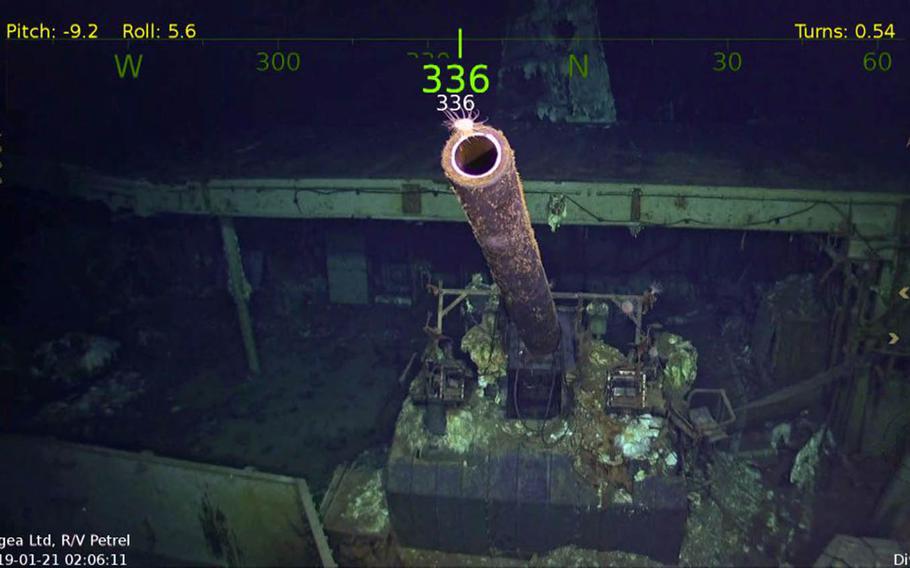
A 5-inch gun on the wreck of the USS Hornet, which was discovered in late January under 3 miles of water near the Solomon Islands in the South Pacific Ocean. (Courtesy the Paul G. Allen estate)
Searchers have found the wreck of the World War II-era aircraft carrier USS Hornet, which played a role in the famed Doolittle Raid on Tokyo and the pivotal Battle of Midway.
The wreckage was discovered in late January by the crew of the research vessel Petrel more than 3 miles beneath the surface of waters near the Solomon Islands in the South Pacific Ocean where it sank in October 1942.
“We had the Hornet on our list of WWII warships that we wanted to locate because of its place in history as a (capital) carrier that saw many pivotal moments in naval battles,” Robert Kraft — director of subsea operations for Vulcan Inc., the private company overseeing the Petrel’s excursions — said in a statement.
The Petrel’s continuing search missions are among the many activities funded by Paul Allen, a co-founder of Microsoft who died in October.
“Paul Allen was particularly interested in aircraft carriers, so this was a discovery that honors his memory,” Kraft said.
The ship appears well-preserved in published photographs, among them one of the ship’s 5-inch guns, a blast-hole in the hull and an International Harvester brand aircraft tug sitting upright on a deck plate as though awaiting its next task.
The Hornet sank during the Battle of the Santa Cruz Islands after a devastating assault from Japanese dive-bombers, torpedo planes and two destroyers.
One hundred-forty sailors of a crew of almost 2,200 died in the attack.
The 10-person expedition team on the 250-foot research boat found the Hornet’s position about 17,500 feet below the surface by “piecing together data from national and naval archives that included official deck logs and action reports from other ships engaged in the battle,” the statement said. “Positions and sightings from nine other U.S. warships in the area were plotted on a chart to generate the starting point for the search grid.
“In the case of the Hornet, she was discovered on the first dive mission of the Petrel’s autonomous underwater vehicle and confirmed by video footage from the remotely operated vehicle, both pieces of equipment rated to dive down to [3.7 miles].”
While the Doolittle Raid of April 1942 on the Japan mainland was of little tactical significance, it did serve as a huge boost to American morale to a country still stinging from the Japanese surprise attack on Pearl Harbor, Hawaii, on Dec. 7, 1941.
The crews of 16 B-25B bombers practiced at Eglin Field in Florida to take flight in only 300 feet, which was the length of the flight deck on the USS Hornet.
They boarded the carrier in San Francisco, which set sail for the Western Pacific on April 2, 1942. All 16 aircraft were lost after the raid on April 18, 1942; three crew members were killed and eight fell into the hands of the Japanese.
By late April 1942 the Hornet was on another mission, heading toward Australia to join the Battle of the Coral Sea, which ended before the ship arrived.
About a month later, in early June 1942, the Hornet, along with the carriers Yorktown and Enterprise, were among the ships that defeated an attacking fleet of the Imperial Japanese Navy near Midway Atoll, about 1,300 miles northwest of Hawaii.
The Hornet’s planes helped sink the heavy cruiser Mikuma, and the decisive battle ended with the Hornet’s attack on the heavy cruiser Mogami, which was left crippled and burning.
The Hornet’s end came on Oct. 27, 1942, during a sustained attack by Japanese planes and destroyers during the Battle of the Santa Cruz Islands, a short but fierce clash at sea.
Within a span of 15 minutes, the Hornet was slammed by three bombs from dive bombers, one of which crashed into the carrier after being hit. Torpedo planes made two direct hits, taking out most of the ship’s electrical systems and engines. Another dive bomber crashed into the bow.
With power out, the Hornet was unable to launch or land planes. Vice Adm. William Halsey ordered that it be abandoned and scuttled, but the American ships were forced to leave before completing the task.
Two Japanese destroyers launched torpedoes that finally sank the Hornet.